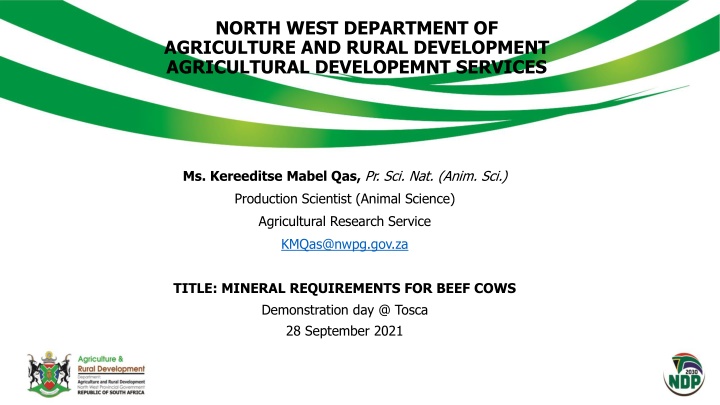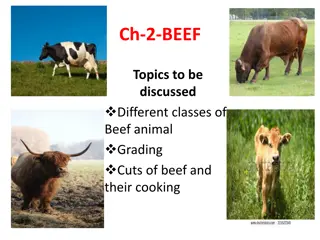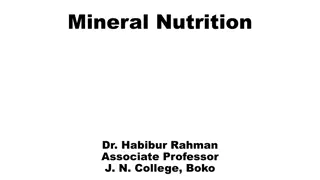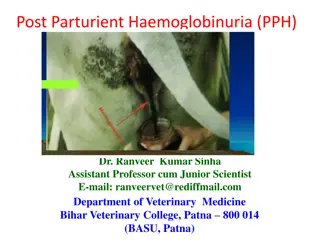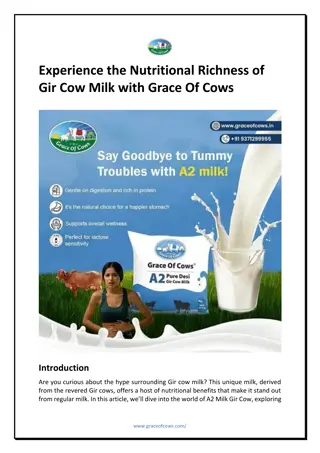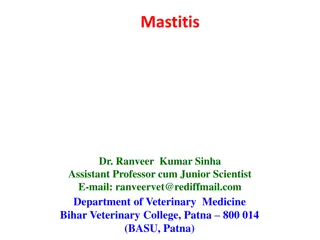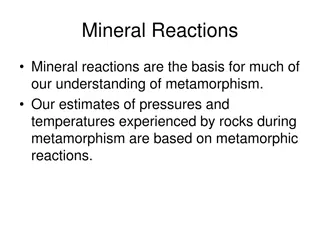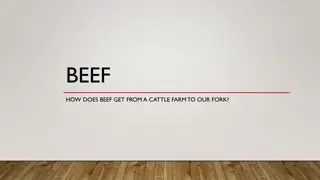Mineral Requirements for Beef Cows Demonstration Day at Tosca
Essential minerals play a crucial role in the growth and reproductive performance of beef cows. Divided into macro and micro categories, these minerals are necessary for skeletal development, milk production, and overall body function. While some minerals are readily available in forage, supplementation is often needed to ensure optimal health and performance. Care must be taken to avoid over-supplementation, which can lead to environmental issues. Understanding the specific mineral requirements of beef cattle is key to maintaining their well-being and productivity.
Download Presentation

Please find below an Image/Link to download the presentation.
The content on the website is provided AS IS for your information and personal use only. It may not be sold, licensed, or shared on other websites without obtaining consent from the author.If you encounter any issues during the download, it is possible that the publisher has removed the file from their server.
You are allowed to download the files provided on this website for personal or commercial use, subject to the condition that they are used lawfully. All files are the property of their respective owners.
The content on the website is provided AS IS for your information and personal use only. It may not be sold, licensed, or shared on other websites without obtaining consent from the author.
E N D
Presentation Transcript
NORTH WEST DEPARTMENT OF AGRICULTURE AND RURAL DEVELOPMENT AGRICULTURAL DEVELOPEMNT SERVICES Ms. Kereeditse Mabel Qas, Pr. Sci. Nat. (Anim. Sci.) Production Scientist (Animal Science) Agricultural Research Service KMQas@nwpg.gov.za TITLE: MINERAL REQUIREMENTS FOR BEEF COWS Demonstration day @ Tosca 28 September 2021
Introduction Many Mineral elements are essential nutrients with very specific function. They are required in a small amounts but deficiencies could produce significant reductions in growth and reproduction. The mineral elements are divided into two groups: macro minerals and micro minerals (Trace). Macro minerals are expressed as % in a ration on a dry matter (DM) basis. Micro minerals needs are expressed in ppm or mg/kg (10 ppm of a mineral equal 10mg/kg of ration dry matter).
Requirements and Function of Minerals Beef cattle requires approximately seventeen minerals. However certain minerals requirements are not listed, because research data are not sufficient to determine requirements. Macro minerals required by beef cattle include Ca, Mg, P, K, Na, Cl and S. Micro minerals required are Cr, Co, Cu, I, Fe, Mn, Se and Zn. Maximum tolerable concentration for a mineral is defined as the dietary level that when fed for a limited period of time, will not impair performance.
Requirements and Function of Minerals Many of the essential minerals are usually found in sufficient concentrations in roughage. Other minerals are frequently insufficient in forage, and supplementation is necessary to optimize animal performance or health. Supplementing diets at concentrations in excess of requirements greatly increases mineral loss in cattle waste.
Requirements and Function of Minerals Over supplementation of minerals should be avoided to prevent possible environmental problems associated with runoff from waste or application of cattle waste to soil. Requirement is influenced by factors such as age, weight, and type and stage of production. The functions of minerals are for skeletal development including bone and tooth formation (Ca, P, Mg), and normal growth and reproduction (P, Cu, Zn, Mn, Se).
Requirements and Function of Minerals The skeleton provides a large reserve of phosphorus that can be drawn on during periods of inadequate phosphorus intake in mature animals. Milk production (Ca) and basis body function; minerals essential for the normal functions of basic systems in the body such as the nervous system (Mg, K, NaCl, S, Co, I, Fe). NaCl (salt) requirement for beef cattle is quite low (0.2% of the dry matter).
Sources of Mineral Elements Many factors influenced the amount and availability of minerals in pastures. As the plant matures mineral availability in the forages decreases. A number of complex interaction in a cow body influence elemental availability and it is difficult to determine how much of an individual element is required for each critical physiology function.
Sources of Mineral Elements Phosphorus may be deficient in some beef cattle rations, because roughages often are low in phosphorus. Furthermore, as forage plants mature, their phosphorus content declines, making mature and weathered forages a poor source. Major supplemental sources of macro-minerals are Limestones (Ca), dicalcium Phosphate and Monosodium phosphate (P), Stock salt (NaCl), Magnesium oxide (Mg) and Potassium chloride (K).
Sources of Mineral Elements Trace minerals are available in two forms which is inorganic and organic element sources. Inorganic minerals are the most common form because they are less expensive and more concentrated than organic sources and are differences in the relative availability. The organic sources of a trace mineral have been shown to be more effectively absorbed by the animal.
Common deficiency Phosphorus is often discussed in conjunction with calcium because the two minerals function together in bone formation. Calcium deficiency in young animals, prevents normal bone growth, thus causing rickets and retarding growth and development. Rickets can be caused by a deficiency of calcium and phosphorus. In grazing livestock, phosphorus deficiency has been described as the most prevalent mineral deficiency throughout the world.
Common deficiency Phosphorus deficiency results in reduced growth and feed efficiency conversion, decreased appetite, impaired reproduction, reduced milk production, and weak, fragile bones. Magnesium deficiency is seen in the spring in more mature grazing cattle under field conditions (ie, grass tetany). The initial signs are nervousness, reduced feed intake, and muscular twitching about the face and ears. Animals are uncoordinated and walk with a stiff gait.
Common deficiency In advanced stages, affected cows fall to the ground, convulse, and die shortly. Cattle do not depend on dietary vitamin B12, because ruminal microorganisms can synthesize it from dietary cobalt. Cobalt deficiency is a relative vitamin B12deficiency, and such cattle show weight loss, poor immune function, unthriftiness, fatty degeneration of the liver, and pale skin and mucosa.
Common deficiency Its requirements in cattle can be met adequately by feeding stabilized iodized salt. Signs of a salt deficiency are rather nonspecific and include pica and reduced feed intake, growth, and milk production. Signs of a selenium deficiency include unthriftiness, weight loss, reduced immune response, and decreased reproductive performance.
Common deficiency Signs of problem Mineral elements Commonly deficient Magnesium Calcium and Phosphorus Excitability and convulsions (Grass Tetany) Tender joint and Stiff legs with arched back (calves), weak brittle bones (cow) Reduced fertility and poor weaning weights (when energy protein are adequate) Anaemia and depigmentation of hair Calves born hairless Calves show stiffness in front legs and lameness (White muscle disease) Excessive Salvation, listlessness, scaly lesions (parakerotosis) Phosphorus Copper Iodine Selenium Zinc
Mineral requirements and Maximum tolerable concentrations Requirement Cows Macro mineral Unit Gestating Lactating Maximum Tolerable Concentrations Calcium % 0.21 0.30 - Magnesium % 0.12 0.20 - Phosphorus % 0.15 0.19 - Potassium % 0.60 0.70 3.00 Sodium % 0,06 0,08 0.10 - Sulfur % 0.15 0.15 0.40
Mineral requirements and Maximum tolerable concentrations Requirement Cows Gestating Micro mineral Unit Lactating Maximum Tolerable Concentrations 10.00 100.00 50.00 1.000.00 1.000.00 2.00 500.00 Cobalt Copper Iodine Iron Manganese Selenium Zinc ppm ppm ppm ppm ppm ppm ppm 0.10 10.00 0.50 50.00 40.00 0.10 30.00 0.10 10.00 0.50 50.00 40.00 0.10 30.00
Developing Mineral Supplementation Program Mineral Supplementation strategies differ among producers. As a general rule mineral program should include NaCl (salt). It is sound management to provide a free-choice salt mineral mixture tailored to the environment and production class of the grazing cattle. Mineral supplementation strategies must respond to the mineral needs of the animal. Ca & P should be the focal point in the mineral program.
Summary Benefits of mineral supplementation - optimum feed intake, which leads to higher mass increase, improved growth, fertility and reproduction; Stronger bone structure and teeth. Common deficiencies - Decrease in appetite, decline in condition and reproduction; Deviant eating habits (pica) animals start to gnaw on bones, poles, trees, soil, etc., which can lead to diseases;
Summary Stiff sickness (joints swell, bones weaken as the body starts to extract phosphate from the skeleton); Low milk production, which leads to poor pre-weaning growth in young animals and ultimately a poor weaning mass with a negative effect on animal performance and profit.
Thank you Ms K.M Qas Pr. Sci. Nat (Anim. Sci.) Production Scientist: Animal Science Agricultural Research Services 114 Chris Hani Street 018-294 3049 086 6109 710 (fax) KMQas@nwpg.gov.za
